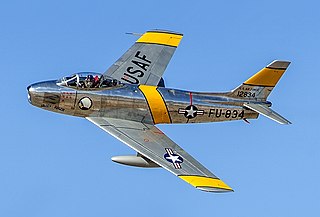
The North American F-86 Sabre, sometimes called the Sabrejet, is a transonic jet fighter aircraft. Produced by North American Aviation, the Sabre is best known as the United States' first swept-wing fighter that could counter the swept-wing Soviet MiG-15 in high-speed dogfights in the skies of the Korean War (1950–1953), fighting some of the earliest jet-to-jet battles in history. Considered one of the best and most important fighter aircraft in that war, the F-86 is also rated highly in comparison with fighters of other eras. Although it was developed in the late 1940s and was outdated by the end of the 1950s, the Sabre proved versatile and adaptable and continued as a front-line fighter in numerous air forces.
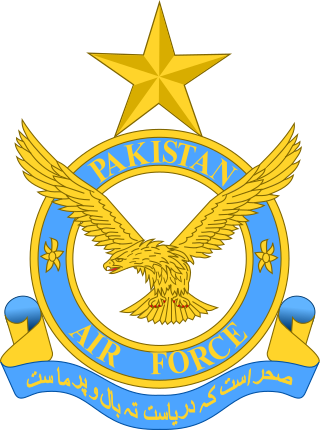
The Pakistan Air Force (PAF) is the aerial warfare branch of the Pakistan Armed Forces, tasked primarily with the aerial defence of Pakistan, with a secondary role of providing air support to the Pakistan Army and Pakistan Navy when required, and a tertiary role of providing strategic airlift capability to Pakistan. As of 2024, as per the International Institute for Strategic Studies, the PAF has more than 70,000 active-duty personnel. PAF stands as the eight largest Air Force in the world. PAF is the largest Air Force of the Muslim world in terms of aircraft fleet. Its primary mandate and mission is "to provide, in synergy with other inter-services, the most efficient, assured and cost effective aerial defence of Pakistan." Since its establishment in 1947, the PAF has been involved in various combat operations, providing aerial support to the operations and relief efforts of the Pakistani military. Under Article 243, the Constitution of Pakistan appoints the President of Pakistan as the civilian Commander-in-Chief of the Pakistan Armed Forces. The Chief of the Air Staff (CAS), by statute a four-star air officer, is appointed by the President with the consultation and confirmation needed from the Prime Minister of Pakistan.

Flying Officer Nirmal Jit Singh Sekhon, PVC was an officer of the Indian Air Force. He was posthumously awarded the Param Vir Chakra, India's highest military decoration during war time, in recognition of his lone defence of Srinagar Air Base against a Pakistan Air Force (PAF) air raid during the Indo-Pakistani War of 1971. He is the only member of the Indian Air Force to be honoured with the PVC.

Squadron Leader Sarfaraz Ahmed Rafiqui was a Pakistani fighter pilot who is known for his gallant actions in two of the aerial dogfights during the Indo-Pakistani War of 1965, and is a recipient of both the Hilal-e-Jurat and the Sitara-e-Jurat military awards from the Government of Pakistan.
The Hilal-e-Jurat is the second-highest military award of Pakistan out of a total of four gallantry awards that were created in 1957. In order of rank it comes after the Nishan-e-Haider coming before the Sitara-e-Jurat.
The Indian Air Force was established on 8 October 1932 independently of the army and navy and in a similar format to the British Royal Air Force. It had been a recommendation of the Skeen Committee, which had been tasked to look into demands for the Indianisation of the Indian army. Its first squadron was raised on 1 April 1933.
Air Chief Marshal Kaleem SaadatNI(M) HI(M) SI(M) TI(M) LoH is a retired four-star air officer in the Pakistan Air Force who served as the Chief of Air Staff from 18 March 2003 until retiring on 20 March 2006. His appointment came after an air crash that killed Air Chief Marshal Mushaf Ali Mir, the air chief, along with several other high-ranking Air Force officers on 19 February 2003. He is the President of the Centre for Aerospace and Security Studies.
The H-4 SOW is a precision-guided glide bomb manufactured by NESCOM and deployed by the Pakistan Air Force, capable of striking targets at stand-off range. It has a terminal guidance system based on an infrared homing seeker, which identifies the target during the final stage of flight. Designed to hit targets out to 120 km, the bomb may have the capability to evade radar.
Air Chief Marshal Parvaiz Mehdi QureshiNI(M) HI(M) SI(M) SBt best known as PQ Mehdi, is a retired four-star air officer and former fighter pilot who served as the eighth Chief of Air Staff (CAS) of the Pakistan Air Force from 1997 until his retirement in 2000.
Air Commodore Abdus Sattar Alvi, SJ, SI(M), is a retired one-star rank air officer and a fighter pilot in the Pakistan Air Force, who is renowned for his gallant actions during the third Indo-Pakistani in 1971, and served as a military advisor in the Syrian Air Force during the Yom Kippur War of 1973.

No. 11 Squadron, named the Arrows, is a Pakistan Air Force (PAF) fighter squadron assigned to the No. 39 Multi-Role Wing of the PAF Southern Air Command. It operates the Block 15 MLU model of the F-16 Fighting Falcon with a multi-role tasking and is also an Operational Conversion Unit (OCU).
The history of the Pakistan Air Force (PAF) began when it was established in 1947 following the independence of Pakistan.
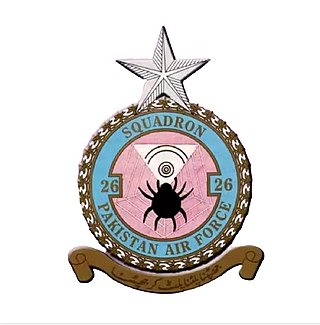
The No. 26 Squadron, nicknamed the Black Spiders, is a multi-role squadron of the Pakistan Air Force's Northern Air Command. It is currently based at Peshawar Airbase and operates the PAC JF-17 Thunder multirole fighter jets.

Saiful Azam (Bengali: সাইফুল আজম; was a Bangladeshi fighter pilot, ace, and politician who first served as a fighter pilot for the Pakistan Air Force and later the Bangladesh Air Force. According to Pakistani sources, during his career as PAF pilot, he shot down one Indian Air Force and four Israel Air Force aircraft. For his actions, he received various gallantry awards from Pakistan, Jordan and Iraq. He also took part in 12 ground-attack missions against the Indian forces. After the liberation of Bangladesh, he joined the newly formed Bangladesh Air Force.
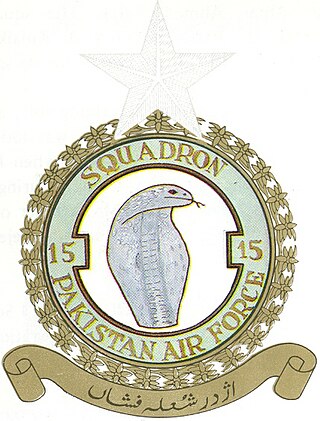
The No. 15 Squadron, nicknamed Cobras, is a tactical attack squadron of the Pakistan Air Force (PAF). The Squadron is currently based at PAF Base Minhas in Kamra, Punjab, Pakistan and equipped with Chengdu J-10C multirole fighter jets. The Squadron also carries the honour of achieving the first kill for the PAF.

No. 8 Squadron, nicknamed the Haiders, is a tactical attack squadron from the No. 32 TA Wing of the Pakistan Air Force's Southern Air Command. It is currently deployed at Masroor Airbase and operates the JF-17A Multi-role fighter.

The No. 25 Squadron, nicknamed Eagles, is a tactical attack squadron from the No. 34 Wing of the Pakistan Air Force's Central Air Command. It is currently deployed at Rafiqui Airbase and operates ROSE upgraded Dassault Mirage-5EF aircraft.

The No. 23 Squadron, nicknamed Talons, is an air superiority fighter squadron of the Pakistan Air Force. It is based at PAF Base Samungli in the Balochistan province of Pakistan and operates the Chengdu F-7PG aircraft.
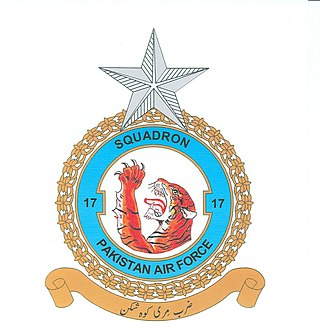
The No. 17 Squadron nicknamed Tigers, is an air superiority squadron of the Pakistan Air Force's Northern Air Command. It is currently deployed at Peshawar Air Base and operates the Chengdu F-7PG aircraft.

Flight Lieutenant Yunus HussainSJ was a Pakistan Air Force officer who shot down 2 Hawker Hunters, one being flown by F/O AR Gandhi of the Indian Air Force over Halwara. Shortly after, Yunus was shot down in the same area by F/L Vinod Neb after making a mistake by turning to the left into Nebs range. He is considered one of the greatest war heroes of Pakistan during the Indo-Pakistani War of 1965. Yunus Hussain received the green endorsement award twice from C-in-Chief Pakistan Air Force Asghar Khan. This recognition was in honor of his passion for flying, which led him to achieve the fastest 500 and then 1000 flying hours in the PAF.















